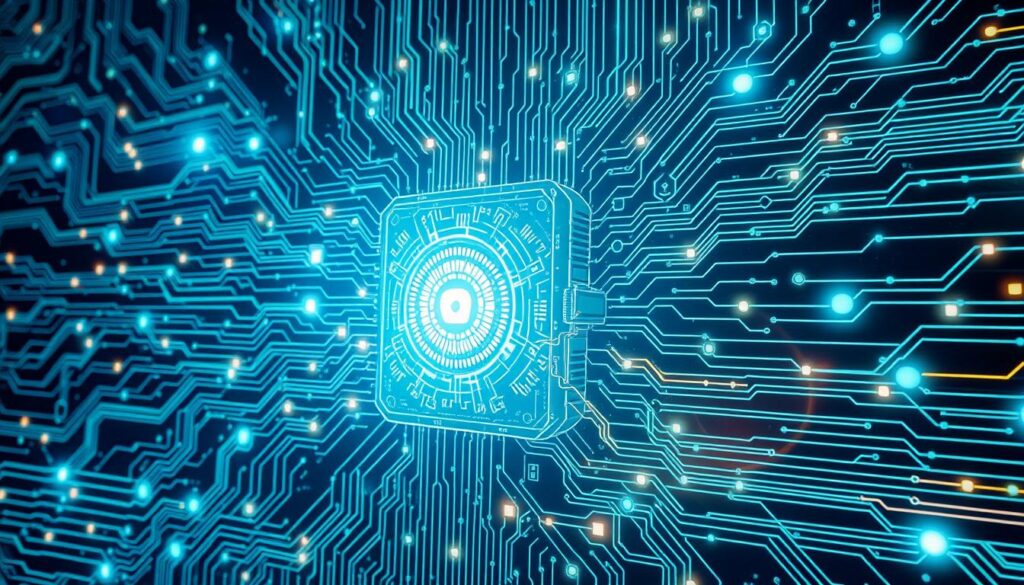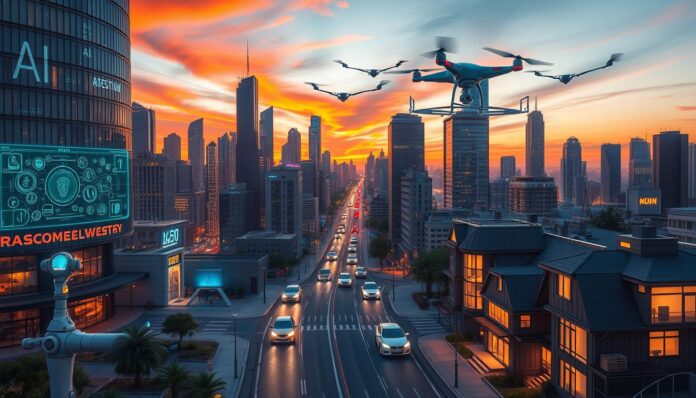The Artificial Intelligence (AI) market is set to hit 267.4 billion GBP by 2025. This shows how much AI has changed industries since it started in 1956. AI lets machines learn, adapt, and do tasks like humans. It uses algorithms to understand what humans want and how to get it, mimicking human smarts through learning, reasoning, and solving problems.
Thank you for reading this post, don't forget to subscribe!Key Takeaways
- AI enables machines to learn, adapt, and perform human-like tasks
- AI uses algorithms to understand and achieve human goals
- AI simulates human intelligence through knowledge discovery, reasoning, and problem-solving
- The AI market is expected to reach 267.4 billion GBP by 2025
- Real AI is distinguished from simple rule-based systems or marketing ploys
Understanding Artificial Intelligence Fundamentals
Artificial Intelligence (AI) is a field that makes machines smarter. It’s about creating systems that can learn and solve problems like humans do.
Definition and Core Concepts
AI lets machines act smart, like learning and solving problems. It includes things like understanding language and seeing the world around them.
Historical Evolution of AI Technology
AI started in the 1950s, during World War II. It has grown, faced challenges, and come back stronger. This is thanks to better technology and more data.
Basic Components of AI Systems
AI systems use different ways to be smart. They have parts like neural networks and machine learning. These help AI systems learn and make choices on their own.

| AI Type | Description |
|---|---|
| Weak AI | Designed for specific tasks, lacking general intelligence. |
| Strong AI | Aims to achieve human-level intelligence or surpass it, but not yet realized. |
| Narrow AI | Focused on a specific task, such as playing chess or driving a car. |
| General AI | Aims to mimic human intelligence across a wide range of tasks. |
| Super AI | Surpasses human intelligence across all fields. |
AI is changing the world and making life better for us. The future of AI is full of possibilities. It will make systems smarter and more helpful.
The Role of Machine Learning in Modern AI
Machine Learning is a key part of artificial intelligence (AI). It lets systems get better over time by learning from data. AI can look at lots of data, find patterns, and make predictions or choices.
It’s important for things like recommending products, understanding language, and driving cars on their own. This is why AI can get better at different tasks and in many fields.
Machine Learning is a part of AI that uses algorithms to find insights in data for better decisions. Deep learning, a more advanced version, uses big neural networks to spot complex patterns on its own. AI and machine learning together have many uses, from making things to helping with money and health.
- In manufacturing, AI finds problems with equipment before they break down using IoT, analytics, and machine learning.
- In banking, machine learning helps catch and stop fraud and cyber attacks.
- In healthcare, AI tools look at electronic health records with machine learning to help doctors and find insights automatically.
Machine Learning is a part of AI that lets a machine or system get better with experience. It helps machines learn from data and make decisions on their own. When AI and machine learning work together, they can handle more data, make decisions faster, and work more efficiently.

In summary, Machine Learning is very important in modern AI. It helps systems adapt, learn, and get better at many things. This leads to new ideas and better work in many areas.
Top 10 Characteristics of Artificial Intelligence
Artificial Intelligence (AI) has changed many areas of our lives. It has become a key player in many industries. Let’s look at the top 10 traits that make AI so powerful and versatile.
Learning and Adaptation Capabilities
AI can learn and get better over time. It looks at big datasets to find patterns and trends. This helps AI make smarter choices and adapt to new situations.
Problem-Solving Abilities
AI is great at solving tough problems. It can analyze lots of data and make complex decisions. This is why AI is so good at things like fast trading, medical diagnosis, and improving airport operations.
Natural Language Processing Skills
AI can understand and create human language. This skill is used in virtual assistants, language translation, and analyzing feelings in text.
AI’s ability to learn, solve problems, and understand language makes it very useful. It’s changing many industries and how we use technology. As AI gets better, its impact on our lives will keep growing.
“AI is the future of growth, and every industry will be transformed by it in the coming years.”
| AI Characteristic | Example Applications |
|---|---|
| Learning and Adaptation | Recommendation systems, disease recognition, game playing |
| Problem-Solving | Financial trading, manufacturing automation, customer service |
| Natural Language Processing | Virtual assistants, language translation, sentiment analysis |
AI’s impact on our lives will keep growing. It’s changing industries and how we use technology. AI’s learning, problem-solving, and language skills are opening up new possibilities and driving innovation.
Artificial Neural Networks and Deep Learning
Artificial Neural Networks (ANNs) are key to deep learning, a powerful part of machine learning. They have nodes called artificial neurons that work like the human brain. ANNs go through many layers to learn and change data.
Deep learning uses many-layered neural networks to handle lots of data. It’s great for big, complex data like in medical imaging and finance. It’s also good for tasks like recognizing speech and translating languages.
To make neural networks better, new techniques are being created. These help AI models work faster and more efficiently. They can even move from the cloud to devices, making AI more accessible.
Businesses can use neural networks and deep learning to meet their goals. AI and machine learning can make things more efficient and help understand customers better.
| Artificial Intelligence | Machine Learning | Deep Learning |
|---|---|---|
| Includes many uses like automation and personalized services. | Helps with tasks like fraud detection and demand forecasting. | Works well with big data in areas like medical imaging and finance. |
| Includes machine learning and deep learning as its components. | Allows systems to learn from experiences without being programmed. | Uses neural networks to mimic the brain and classify information. |
| Can be rule-based, knowledge-based, or data-driven. | Includes supervised, unsupervised, or reinforcement learning. | Works on larger data sets than machine learning and includes Unsupervised Pre-trained Networks, Convolutional Neural Networks, etc. |
To use neural networks and deep learning well, businesses should find important uses and start small projects. They should also build skilled teams and invest in data tools and rules. This way, they can use AI/ML to change and improve their work.
Perception and Pattern Recognition in AI
Artificial intelligence (AI) systems use sensors to see their world. This helps them in many areas like computer vision, speech recognition, and monitoring the environment. Computer vision lets machines understand pictures for tasks like recognizing faces and objects. Speech recognition turns spoken words into text, making it easy for humans and machines to talk. These abilities are made better by processing sensory data, helping systems react to their surroundings.
Computer Vision Technologies
Computer vision is key in AI, used in many fields. It’s used in security to spot intruders and in face ID systems. It also helps in visual search by finding and labeling objects in images or videos.
Speech Recognition Systems
Speech recognition lets machines understand spoken words. It’s in voice assistants like Alexa and Siri, making voice control easy. It’s also used in music and voice recognition, showing AI’s wide reach.
Sensory Data Processing
Sensory data processing is vital for AI to sense and react to its environment. It includes machine touch for feeling surfaces and machine smell and taste for detecting odors and tastes. This lets AI systems better understand and interact with their world, opening up new areas like robotics.
AI’s ability to see and understand its world is driving its growth and use. As AI gets better, we’ll see more cool uses of computer vision, speech recognition, and sensory data processing. This will change how we interact with and understand our world.
Autonomous Decision-Making Capabilities
AI systems have become very good at making decisions on their own. This is key in places where quick changes are needed. For example, in self-driving cars, AI looks at sensor data and safety rules to decide how to drive. AI also helps in many other areas, like robotics, finance, and security, by adapting to new info and situations.
The growth in ai decision-making, autonomous systems, and intelligent algorithms has made AI much better at solving problems. More companies are using AI to make their work better and more efficient.
In healthcare, AI helps doctors by looking at patient data and medical studies to guide treatment. In finance, AI makes trades and checks for fraud using current market data.
“AI’s autonomous decision-making capabilities are transforming industries, empowering organizations to respond swiftly to evolving challenges and opportunities.”
As more companies use autonomous systems and intelligent algorithms, AI’s role in making decisions is growing. The future looks bright for AI in making businesses better, safer, and more competitive.
Autonomous Decision-Making in Action
- Autonomous vehicles navigating through complex traffic conditions
- AI-powered financial trading systems executing transactions based on market trends
- Robotic systems in manufacturing adapting to changes in production processes
- Cybersecurity AI detecting and responding to evolving cyber threats in real-time
As ai decision-making gets better, more companies will benefit from these autonomous systems and intelligent algorithms. The future looks exciting for AI in making decisions, changing how businesses work.
Data Processing and Analysis Features
In today’s world, artificial intelligence (AI) is key for handling big data. It’s great at processing lots of information. This makes AI essential in our data-driven society.
Big Data Management
AI helps manage big data by analyzing complex information. It lets companies find important insights from huge datasets. AI can also process data quickly, helping in fast decision-making in areas like finance and computing.
Real-time Analytics
AI makes it possible for businesses to make quick decisions. It helps them keep up with market changes and what customers want. AI can analyze data as it comes in, offering personalized advice and content for online shopping and streaming.
Predictive Modeling
AI’s predictive models are changing many industries. They help forecast what people will buy and when machines might break down. AI uses machine learning to spot trends and make accurate predictions. This helps companies plan for the future.
| AI Data Processing Characteristics | Benefits |
|---|---|
| Big Data Management | Extracting insights from large, complex datasets |
| Real-time Analytics | Enabling quick decision-making and personalized experiences |
| Predictive Modeling | Forecasting consumer behavior and equipment failures |
“AI’s data processing and analysis capabilities are transforming how organizations make decisions and stay competitive in today’s fast-paced, data-driven landscape.” – AI Industry Expert
AI Automation and Robotics Integration
The mix of AI and automation is changing the game worldwide. In manufacturing, robots and AI systems take on tough and repetitive jobs. This makes work smoother and more efficient. It’s also changing customer service with chatbots and virtual agents, and making data entry easier.
AI automation lets tasks run with little human help. For example, robotic process automation does tasks like data entry and form filling. It uses AI to set up software robots. This blend of ai automation, robotics, and industrial ai is changing how businesses work. It makes processes smoother and more efficient.
AI robots are also used in manufacturing for jobs that are dangerous or repetitive. They make work safer and more productive. These robotic systems, with their advanced ai automation, are changing the industrial scene. They make workflows better and ease the load on human workers.
As AI automation and robotics become more common, industries see big wins. They save money, work better, and stay safer. This use of new tech is shaping the future of work. It helps businesses stay ahead and meet changing market needs.
“AI-powered automation is transforming industries, streamlining operations and increasing efficiency.” – Industry Expert
Cognitive Computing and Reasoning
Cognitive computing and reasoning are key parts of artificial intelligence (AI). They help systems understand and analyze information like humans do. These abilities rely on three main things: how information is stored, logical systems, and expert systems architecture.
Knowledge Representation
Knowledge representation is how AI systems handle and use information. It’s the base for more complex thinking. By storing specific knowledge, AI can make decisions and solve problems. This makes AI think and reason like humans.
Logical Reasoning Systems
Logical reasoning systems help AI make choices based on data. They use different methods like rules and probabilities to make decisions. This way, AI can do tasks that need human skills.
Expert Systems Architecture
Expert systems combine knowledge and reasoning to offer advice in specific areas. They use deep knowledge and reasoning to help humans make better choices. This is especially useful in complex situations.
Cognitive computing and reasoning are changing many fields, like healthcare and finance. They make AI better at tasks that humans used to do. This is because they use advanced thinking and computer models.
“Cognitive computing combines human-like thought processes with computerized models to handle complex situations where answers may be ambiguous, targeting tasks computers traditionally struggle with, like natural language processing and image recognition.”
| Characteristic | AI | Cognitive Computing |
|---|---|---|
| Focus | Automating simple and repetitive tasks efficiently | Handling complex situations with ambiguous answers |
| Key Capabilities | NLP, speech recognition, image processing, video analytics, chatbots | Sentiment analysis, facial recognition, fraud detection, risk assessment |
| Strengths | Expressiveness, data temperament, accurate data analysis | Interactivity, adaptability, statefulness, iterativeness, contextuality |
| Limitations | Data breaches, time-consuming training process | Security challenges, long development cycle, slow adoption, power consumption |
As cognitive computing and reasoning grow, they will be more important in AI’s future.
Human-Machine Interaction Features
Artificial intelligence (AI) systems are getting smarter and more interactive. They can now understand and respond to human emotions and intentions. This change is making user experiences better in many areas, like virtual reality, gaming, and customer service.
AI interfaces can now adjust to how we move, talk, and express ourselves. This makes experiences more real and fun. In customer service, AI chatbots and virtual agents offer more human-like interactions. This boosts customer happiness and overall experience.
AI can understand different types of data, like images, text, and speech. This makes talking to machines easier and more natural. Virtual assistants and conversational interfaces are becoming very popular because of this.
AI keeps getting better as it learns from more data and experiences. This makes it better at giving personalized and easy-to-use interactions. AI’s ability to adapt and improve also makes communication between humans and machines more natural and intuitive.
“AI-powered interfaces can now adapt to user gestures, voice commands, and expressions, creating more immersive and engaging experiences.”
As AI keeps growing, making human-machine interaction better will be key in shaping the future of user experiences. The way humans and AI systems work together will be a big part of the future technology world.
Future Trends in AI Development
Artificial intelligence (AI) is growing fast, bringing exciting changes. Machine learning is getting better, leading to smarter systems. By 2025, AI will do many tasks on its own, says Gartner. The market for AI in cybersecurity will hit $135 billion by 2030, Morgan Stanley forecasts.
The Conversational AI Market is set to grow to $49.9 billion by 2030, MarketsandMarkets predicts.
AI is also merging with new tech like blockchain and IoT. This mix will open up new areas in many fields. Making AI fair and clear is key to its success and trust.
Generative AI, for making content like images and music, will get even better. This will open up new uses beyond simple chatbots and image makers. AI’s growth will change our lives and work in big ways.
Teaching AI skills will be vital for the workforce to keep up. Laws like the EU’s AI Act and China’s deepfake rules will guide AI’s future. This ensures AI is used right.
In short, AI’s future is full of promise. We’ll see better machine learning, new tech combos, and more focus on ethics. As AI evolves, it will change our world in amazing ways.
Conclusion
Artificial Intelligence (AI) is changing the world in big ways. It’s making new things possible in many areas of life. AI can learn, solve problems, understand language, and make choices on its own.
As AI gets better, it will change how we work and live. It will also help us do more things and explore new areas in tech and science. But, we need to think about the right way to use AI, like avoiding bias and protecting privacy.
The ai impact on our lives is clear, thanks to AI tech. Big money is going into AI, making many industries better. The future of AI looks very promising for more tech growth. But, we must think about the good and bad sides of AI’s growth.
AI will keep changing our world and how we see it. It’s used in cars, helpers, health care, and more. By using AI wisely and solving its problems, we can make a better future for all.


